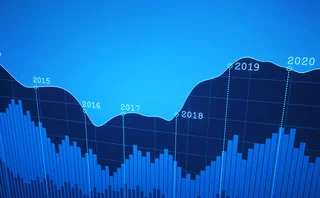
Volatility returns to pre-Lehman levels
Market volatility across several sectors has dropped back to levels last seen before the collapse of Lehman Brothers in September 2008, lending weight to the belief that the financial markets are on the road to recovery.
The Ted spread, the difference between the three-month dollar London interbank borrowing rate and the yield on three-month US Treasury bills, is often used as a measure of perceived interbank lending risk. At close on May 19 it had dropped to 57.2 basis points, the latest point in a long decline that has taken it from a peak of 463bp on October 10 last year.
On September 12 last year, the last trading day before the collapse of Lehman Brothers on September 15, it stood at 134.9bp. Before the start of the general crisis in mid-2007, values of around 50bp were reckoned to represent business as usual.
Commodity market volatility, as represented by the Chicago Board Options Exchange's (CBOE) OVX measure of implied volatility in crude oil options, has also fallen, ending trading yesterday at 41.25 - slightly below the pre-Lehman figure of 45.75 on September 12 - after peaking at 100.42 on December 11. This is still, however, higher than the level the index reached before mid-2007, when it moved between 20 and 30.
The Merrill Lynch Move index, a yield-curve weighted average of the normalised implied volatility of one-month Treasury options, also dropped back to pre-Lehman levels, reaching 122.7 at close of trading on May 19, down from a peak of 264.6 on October 10. It finished September 12 at 125.4.
Two other indexes of market volatility remain slightly above their pre-Lehman marks. The CBOE VIX index of equity price volatility closed at 28.8 yesterday, compared with 25.66 on September 12, and the Deutsche Bank currency volatility index, which is based on the implied volatility of options on nine major currency pairs, closed at 13.89, still higher than the 11.503 level reported on September 12. However, both have fallen significantly since late last year: the VIX peaked at 80.86 on November 20, and currency volatility reached 24.2383 on October 27.
The news provides added weight to the "FedViews" analysis released yesterday by the San Francisco Federal Reserve Bank, which commented: "Not all economic news has been dire over the past couple of months, supporting the view that the economy might be close to its trough."
In particular, economist Bart Hobijn continued: "The financial sector is showing signs of stabilisation. We have seen the resumption of securities issuances in several financial markets that had come to a virtual standstill after September 2008. Stabilisation of financial markets and institutions, as well as fiscal and monetary stimulus, will provide momentum for positive economic growth by the end of this year."
See also: Skew drops to record lows on global equity indexes
An aversion to variance
The risk of value-at-risk
Short-selling ban increased volatility more than credit crisis
Only users who have a paid subscription or are part of a corporate subscription are able to print or copy content.
To access these options, along with all other subscription benefits, please contact info@risk.net or view our subscription options here: http://subscriptions.risk.net/subscribe
You are currently unable to print this content. Please contact info@risk.net to find out more.
You are currently unable to copy this content. Please contact info@risk.net to find out more.
Copyright Infopro Digital Limited. All rights reserved.
You may share this content using our article tools. Printing this content is for the sole use of the Authorised User (named subscriber), as outlined in our terms and conditions - https://www.infopro-insight.com/terms-conditions/insight-subscriptions/
If you would like to purchase additional rights please email info@risk.net
Copyright Infopro Digital Limited. All rights reserved.
You may share this content using our article tools. Copying this content is for the sole use of the Authorised User (named subscriber), as outlined in our terms and conditions - https://www.infopro-insight.com/terms-conditions/insight-subscriptions/
If you would like to purchase additional rights please email info@risk.net
More on Economics
Webinar – Nowcasting the US economy
Join CME Group Chief Economist, Blu Putnam, as he shares insights using alternative data and nowcasting to monitor developments in the US economy.
Fed Funds Futures in a Post-ZIRP World
As the FOMC returns to more active management of its key target rate, Federal Funds futures have experienced dramatic growth.
Challenging economic pessimism: an optimistic note
A contrarian, upbeat view of the long-term economic outlook
Economists, like hedge fund traders, need open minds
Economists, risk managers and traders must learn the lessons of crisis, says Kaminski
Fed wrong not to start QE tapering, says UBS economist
The surprise decision by the Federal Reserve last month not to scale back its quantitative easing programme will create more volatility, says economist
IMF's Blanchard warns Europe could drag world economy down
IMF chief economist says ‘three-speed’ global economy could be dangerous
Most read
- Top 10 operational risks for 2024
- Japanese megabanks shun internal models as FRTB bites
- Market for ‘orphan’ hedges leaves some borrowers stranded







